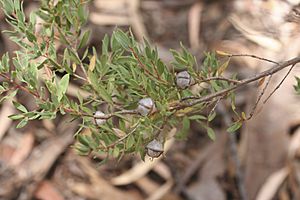Leptospermum sphaerocarpum facts for kids
Quick facts for kids Leptospermum sphaerocarpum |
|
|---|---|
 |
|
| Foliage and fruit | |
| Scientific classification | |
| Genus: |
Leptospermum
|
| Species: |
sphaerocarpum
|
The Leptospermum sphaerocarpum is a type of shrub. It grows only in New South Wales, Australia. This plant has thin bark and oval-shaped leaves with pointy tips. Its flowers can be greenish-white or pink. The fruit of this plant stays on the branches even when it's ripe.
What Does It Look Like?
This Leptospermum shrub usually grows up to 2 m (6 ft 7 in) tall. It has thin, strong bark. Its young stems are often covered with soft hairs.
The leaves are oval-shaped, from 5–10 mm (0.20–0.39 in) long and 2–5 mm (0.079–0.197 in) wide. They have a sharp point at the end. The leaves narrow down to a short, thick stalk called a petiole.
Flowers and Fruit
The flowers are usually greenish-white or pink. They are about 15–20 mm (0.59–0.79 in) wide. Each flower grows by itself on short side branches.
Before the flowers open, there are many reddish-brown bracts at the base of the flower bud. These bracts fall off before the flower blooms. The part that holds the flower, called the floral cup, is very hairy.
The petals are 5–7 mm (0.20–0.28 in) long. The stamens, which are the parts that make pollen, are 4–6 mm (0.16–0.24 in) long. This plant mainly flowers from October to November.
The fruit is a capsule. It is 7–10 mm (0.28–0.39 in) wide. This capsule has woody parts and stays on the plant even after it is mature.
How It Got Its Name
The Leptospermum sphaerocarpum was first officially described in 1932. This was done by a botanist named Edwin Cheel. He wrote about it in the Journal and Proceedings of the Royal Society of New South Wales. Cheel found the first plant samples near a place called Rylstone.
Where Does It Grow?
This tea-tree grows in heathlands and forests. You can find it on sandstone ridges and cliffs. Its habitat stretches from the Warrumbungles in the north. It goes south to the Blue Mountains and the upper Hunter River in New South Wales.

